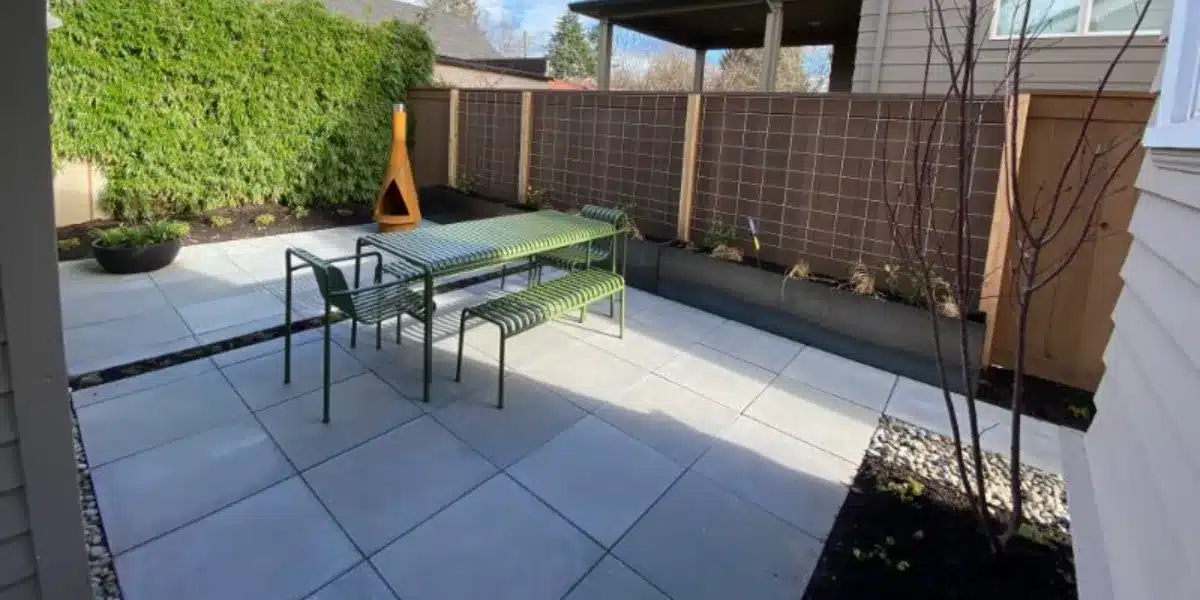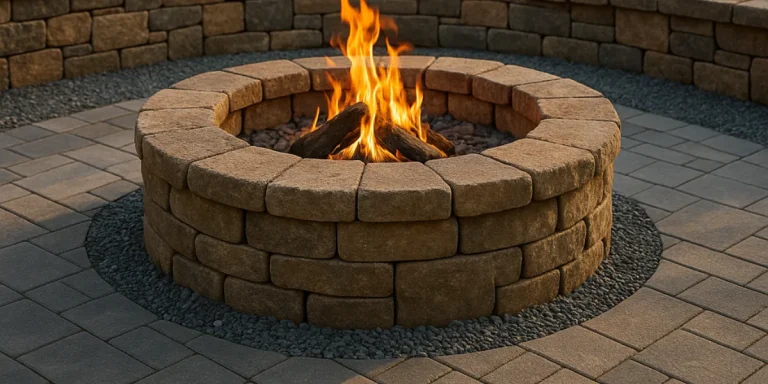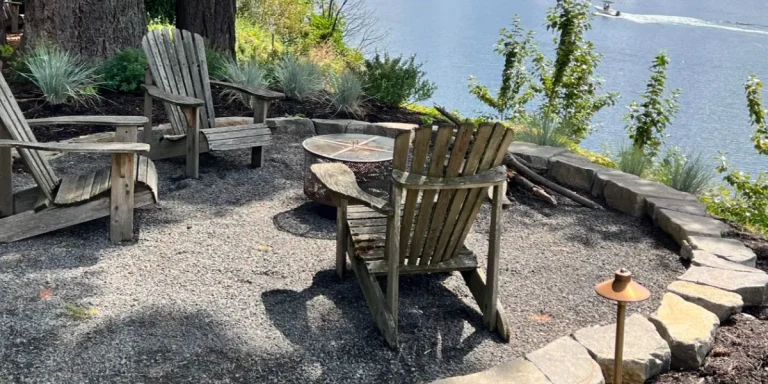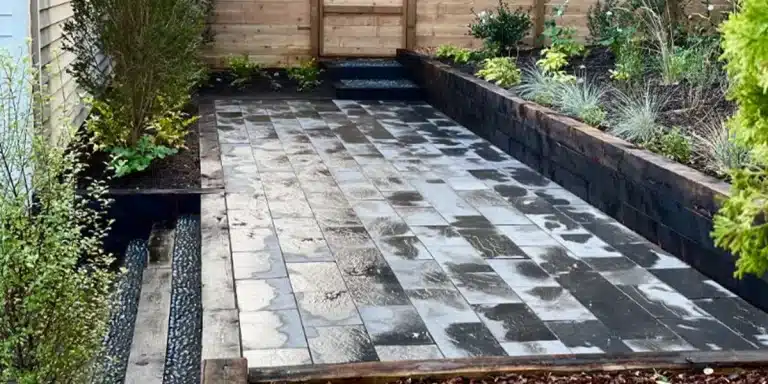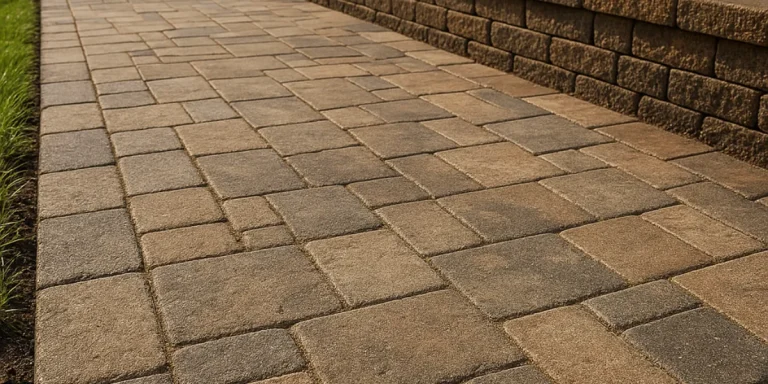Why Your Paver Patio Is Sinking and How to Fix It
A paver patio is meant to be a long-lasting, low-maintenance outdoor feature—but if you’re noticing uneven surfaces, pooling water, or sunken pavers, it’s a clear sign that something has gone wrong beneath the surface. At White Oak Landscapes, we help homeowners in Oregon City, West Linn, and nearby communities fix sinking paver patios and prevent the problem from happening again.
Common causes of a sinking paver patio
If your paver patio is shifting, dipping, or showing signs of unevenness, it’s likely due to what’s happening underneath—not the pavers themselves. At White Oak Landscapes, we’ve repaired countless patios across Oregon City, West Linn, and surrounding areas, and in nearly every case, the root cause can be traced back to problems with the foundation, drainage, or soil conditions.
Here are the most frequent culprits:
1. Poor base preparation
The most common reason a patio starts to sink is that the base wasn’t installed correctly in the first place. Proper base prep is the foundation of a long-lasting patio—and skipping steps during installation can lead to early failure.
Common mistakes include:
-
-
- Shallow excavation (less than 6–8 inches deep)
- Using low-quality or incorrect base materials
- Failing to compact the base in layers
- No use of geo-fabric to prevent soil migration
-
In Clackamas County, where heavy seasonal rain is the norm, any shortcut during base prep leads to erosion, shifting, and sinking over time. A properly installed paver patio should include a minimum of 4–6 inches of compacted crushed rock, a bedding layer of sand, and edge restraints to keep the surface stable.
White Oak Landscapes follows best practices for all hardscape installations, ensuring every layer is compacted, leveled, and built to handle the wet Pacific Northwest climate.
Signs of poor base prep include:
-
-
- Wavy or uneven surfaces
- Pavers that rock or feel loose underfoot
- Water pooling in specific areas after rain
- Cracking or shifting along edges
-
2. Inadequate drainage
Even a well-built patio will eventually sink or shift if water isn’t managed correctly. Without a way to escape, water will accumulate beneath the patio, soften the soil, and cause settling or erosion. This is a widespread issue in Oregon City and other communities prone to prolonged rainfall.
Common drainage-related issues include:
-
-
- Patio sloped toward the home instead of away
- Lack of drainage channels or swales
- Downspouts emptying directly near patio edges
- No subsurface drainage to relieve water pressure
-
At White Oak Landscapes, we address drainage issues by incorporating features like:
-
-
- French drains
- Downspout extensions
- Grading and slope correction
- Drainage swales or dry creek beds
-
These systems ensure your patio—and surrounding landscape—remains dry, stable, and functional year-round.
3. Clay-heavy or unstable soil
The Willamette Valley is known for its dense, clay-rich soil. While good for agriculture, clay is a poor base for hardscaping unless it’s properly mitigated. Clay holds moisture, expands when wet, and contracts when dry, causing ground movement that undermines your patio over time.
Even patios that were initially well-installed may begin to sink as the clay shifts beneath them. This is why understanding local soil conditions is essential when designing outdoor spaces in Happy Valley, Lake Oswego, and other nearby towns.
Our recommended solutions may include:
-
-
- Deeper excavation below the clay layer
- Use of geo-fabric to separate the base from the native soil
- Installing a thicker, well-compacted crushed rock base
- Adding landscape drainage systems to control groundwater
-
When needed, we also integrate retaining walls and regrading to help stabilize the surrounding area.
4. Tree roots and organic material
Organic matter like roots, leaves, or topsoil in the sub-base will eventually break down and collapse, creating voids under the patio. Likewise, growing tree roots can push up or displace pavers, especially near older trees or garden borders.
This issue is common in older patios or DIY projects that skipped soil screening and stabilization. If left unchecked, entire sections of your patio can shift or buckle, creating both an eyesore and a tripping hazard.
Long-term solutions include:
-
-
- Excavating and removing decaying organic matter
- Installing a compacted sub-base with clean materials
- Root pruning or tree removal if necessary
- Rebuilding the patio on a stable foundation with proper drainage
-
When clients choose White Oak Landscapes to restore or rebuild a patio, we go beyond surface fixes to ensure the entire foundation is clean, solid, and properly compacted—whether it's part of a full landscape renovation, a new lawn installation, or an integrated outdoor living space.
How we repair a sinking patio
At White Oak Landscapes, we don’t believe in surface-level fixes. If your paver patio is sinking, our goal is to restore it properly—from the ground up—so you can enjoy a safe, level, and beautiful outdoor space for years to come. We’ve refined a step-by-step repair process that eliminates the cause of the problem and ensures long-lasting results, especially in the challenging soil and climate conditions we see throughout Oregon City and surrounding areas.
Here’s what our professional repair process looks like:
Step 1: Assess the damage and identify the cause
We begin with a thorough on-site inspection to evaluate:
-
-
- The extent of the sinking
- Patterns of water movement
- Soil composition
- Drainage conditions
- Potential structural concerns
-
This evaluation allows us to create a custom repair plan tailored to your specific situation. Whether your patio was installed improperly, affected by poor drainage, or undermined by tree roots or clay soil, we’ll determine exactly what’s needed to fix it permanently.
Step 2: Carefully remove the affected pavers
Using specialized tools, we remove only the sections that have sunk or shifted. Care is taken not to damage the surrounding patio. Salvageable pavers are cleaned and stored safely for reinstallation. If any pavers are broken or excessively worn, we can source matching replacements from our trusted hardscape suppliers.
This approach minimizes waste and keeps your patio looking consistent.
Step 3: Excavate and rebuild the base
Once the surface is removed, we dig out the compromised base materials—whether it’s eroded gravel, wet clay, or decaying organic matter. We then rebuild the foundation using high-quality crushed gravel, compacted in multiple layers using plate compactors to meet industry standards.
In this step, we may also:
-
-
- Install geo-fabric to prevent soil migration
- Excavate deeper to reach more stable soil
- Incorporate structural elements if needed (such as retaining walls or edge restraints)
-
To prevent future water problems, we often include drainage improvements such as:
-
-
- French drains
- Catch basins
- Drainage swales
- Dry creek beds
- Downspout redirection
-
These upgrades are essential in our region’s rainy climate and are especially important if your patio is close to your home, lawn, or landscaped beds.
Step 4: Reset and level the pavers
With the new base fully compacted and leveled, we reinstall the pavers with precision. Each paver is placed to create a flat, uniform surface with proper slope for drainage (typically a 1–2% slope away from structures). We then apply polymeric sand between the joints to lock the pavers in place and prevent weed growth or shifting.
This step is where your patio starts to come back to life—with a stable, attractive surface you can use right away.
Step 5: Seal and protect (optional, but recommended)
As a finishing touch, we offer the option to apply a professional-grade paver sealant. Sealing protects against:
-
-
- Water infiltration
- Staining from leaves, moss, or spills
- Surface erosion and color fading
-
It also enhances the color and texture of your pavers and makes routine maintenance easier. Many homeowners opt to include this during a patio restoration, especially if the space is used frequently or exposed to constant moisture.
Preventative upgrades worth considering
If your patio is sinking, it may also be time to improve the surrounding landscape. Many clients use this opportunity to:
-
- Add a seat wall, fire pit, or outdoor kitchen
- Improve drainage throughout the yard
- Refresh surrounding mulch beds, plantings, or lighting
We offer complete landscape design and hardscape installation services, and we’re happy to help you turn a repair project into a backyard transformation.
Proudly serving Oregon City and surrounding areas
White Oak Landscapes provides professional paver patio repair and installation services in:
-
- Oregon City
- West Linn
- Lake Oswego
- Happy Valley
- Clackamas
- Milwaukie
- Tualatin
- Wilsonville
- Canby
- Gladstone
- Beavercreek
- Estacada
- Damascus
Get your patio fixed the right way
Don’t let a sinking patio drag down your outdoor space.
Contact White Oak Landscapes today to schedule an on-site consultation and let our experienced team restore your paver patio to its original beauty and function. We serve Oregon City and the surrounding region with high-quality hardscaping, drainage, and landscape design services you can rely on.
Let’s build something beautiful—and solid—for years to come.

